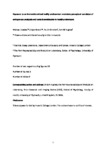Exposure to an Immersive Virtual Reality Environment can Modulate Perceptual Correlates of Endogenous Analgesia and Central Sensitization in Healthy Volunteers
| dc.contributor.author | Mehesz, E | |
| dc.contributor.author | Karoui, H | |
| dc.contributor.author | Strutton, PH | |
| dc.contributor.author | Hughes, Sam | |
| dc.date.accessioned | 2022-01-13T11:53:07Z | |
| dc.date.issued | 2021-06 | |
| dc.identifier.issn | 1526-5900 | |
| dc.identifier.issn | 1528-8447 | |
| dc.identifier.uri | http://hdl.handle.net/10026.1/18551 | |
| dc.description.abstract |
Virtual reality (VR) has been shown to produce analgesic effects during different experimental and clinical pain states. Despite this, the top-down mechanisms are still poorly understood. In this study, we examined the influence of both a real and sham (ie, the same images in 2D) immersive arctic VR environment on conditioned pain modulation (CPM) and in a human surrogate model of central sensitization in 38 healthy volunteers. CPM and acute heat pain thresholds were assessed before and during VR/sham exposure in the absence of any sensitization. In a follow-on study, we used the cutaneous high frequency stimulation model of central sensitization and measured changes in mechanical pain sensitivity in an area of heterotopic sensitization before and during VR/sham exposure. There was an increase in CPM efficiency during the VR condition compared to baseline (P < .01). In the sham condition, there was a decrease in CPM efficiency compared to baseline (P < .01) and the real VR condition (P < .001). Neither real nor sham VR had any effect on pain ratings reported during the conditioning period or on heat pain threshold. There was also an attenuation of mechanical pain sensitivity during the VR condition indicating a lower sensitivity compared to sham (P < .05). We conclude that exposure to an immersive VR environment has no effect over acute pain thresholds but can modulate dynamic CPM responses and mechanical hypersensitivity in healthy volunteers. | |
| dc.format.extent | 707-714 | |
| dc.format.medium | Print-Electronic | |
| dc.language | en | |
| dc.language.iso | en | |
| dc.publisher | Elsevier BV | |
| dc.subject | Endogenous analgesia | |
| dc.subject | virtual reality | |
| dc.subject | secondary hyperalgesia | |
| dc.subject | central sensitization | |
| dc.title | Exposure to an Immersive Virtual Reality Environment can Modulate Perceptual Correlates of Endogenous Analgesia and Central Sensitization in Healthy Volunteers | |
| dc.type | journal-article | |
| dc.type | Journal Article | |
| plymouth.author-url | https://www.webofscience.com/api/gateway?GWVersion=2&SrcApp=PARTNER_APP&SrcAuth=LinksAMR&KeyUT=WOS:000659279900006&DestLinkType=FullRecord&DestApp=ALL_WOS&UsrCustomerID=11bb513d99f797142bcfeffcc58ea008 | |
| plymouth.issue | 6 | |
| plymouth.volume | 22 | |
| plymouth.publication-status | Published | |
| plymouth.journal | The Journal of Pain | |
| dc.identifier.doi | 10.1016/j.jpain.2020.12.007 | |
| plymouth.organisational-group | /Plymouth | |
| plymouth.organisational-group | /Plymouth/Faculty of Health | |
| plymouth.organisational-group | /Plymouth/Faculty of Health/School of Psychology | |
| plymouth.organisational-group | /Plymouth/REF 2021 Researchers by UoA | |
| plymouth.organisational-group | /Plymouth/REF 2021 Researchers by UoA/UoA04 Psychology, Psychiatry and Neuroscience | |
| plymouth.organisational-group | /Plymouth/REF 2021 Researchers by UoA/UoA04 Psychology, Psychiatry and Neuroscience/UoA04 Psychology, Psychiatry and Neuroscience MANUAL | |
| plymouth.organisational-group | /Plymouth/Users by role | |
| plymouth.organisational-group | /Plymouth/Users by role/Academics | |
| dc.publisher.place | United States | |
| dcterms.dateAccepted | 2020-12-29 | |
| dc.rights.embargodate | 2022-1-16 | |
| dc.identifier.eissn | 1528-8447 | |
| dc.rights.embargoperiod | Not known | |
| rioxxterms.versionofrecord | 10.1016/j.jpain.2020.12.007 | |
| rioxxterms.licenseref.uri | http://www.rioxx.net/licenses/all-rights-reserved | |
| rioxxterms.licenseref.startdate | 2021-06 | |
| rioxxterms.type | Journal Article/Review |


